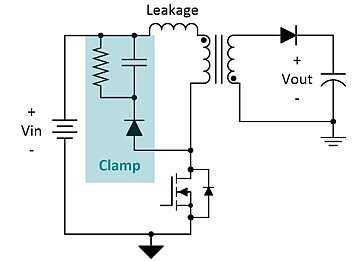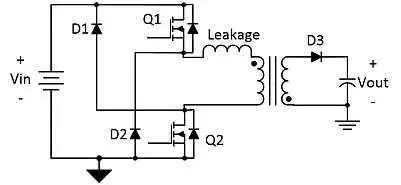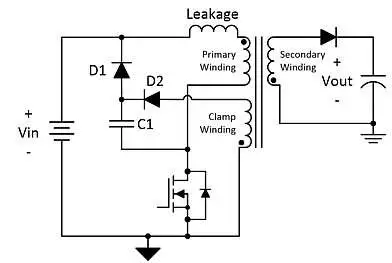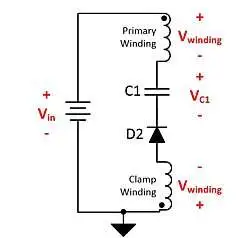SSZTCV1 July 2019 UCC28780 , UCC28782
In the standard form of a flyback converter, the leakage inductance of the transformer creates a voltage spike on the drain of the primary field-effect transistor (FET). Preventing this spike from becoming excessive and damaging, the FET requires a clamping network, usually with a dissipative clamp, as shown in Figure 1. But the power lost in dissipative clamps limits flyback converter efficiency. In this Power Tip, I will investigate two different variations of the flyback converter that use nondissipative clamping techniques to recycle leakage energy and improve efficiency.
 Figure 1 Most flyback converters employ a dissipative clamp.
Figure 1 Most flyback converters employ a dissipative clamp.The power lost in a dissipative clamp is related to energy stored in the leakage inductance of each switching cycle. When the FET is on, the current in the primary winding of the transformer increases to a peak current value determined by the controller. This peak current is flowing in both the primary magnetizing and leakage inductances. When the FET turns off, the magnetizing energy is delivered to the output through the secondary winding of the transformer. The leakage energy is not coupled through the transformer core, so it remains on the primary side and flows into the clamp.
It is important to understand that not only is the leakage energy dissipated in the clamp; so is a portion of the magnetizing energy. As discussed in Power Tip #17, clamping the primary winding voltage much higher than the reflected output voltage minimizes the amount of magnetizing energy burned in the clamp.
The two-switch flyback is a common variation of the flyback converter that reclaims the leakage energy. Figure 2 is a simplified schematic of a two-switch flyback. The two primary FETs are connected in series with the primary winding between them. These two FETs are simultaneously either on or off. When they are on, the primary winding connects to the input and is energized to a peak current. When they turn off, the secondary winding delivers the magnetizing energy to the output, and the leakage energy is recycled back to the input through D1 and D2. By reclaiming the leakage energy, two-switch flybacks boast higher efficiency than their single-switch dissipative clamp counterparts.
 Figure 2 The two-switch flyback
recycles leakage energy to the input.
Figure 2 The two-switch flyback
recycles leakage energy to the input.The efficiency gained is somewhat offset by the fact that two switches are conducting simultaneously, so conduction losses tend to increase, especially in low-input-voltage applications. Luckily, the drain-to-source voltage of both FETs clamp to the input voltage, so you can use lower-voltage-rated FETs compared to a single-switch flyback. The clamped voltage stress is also advantageous in high-input-voltage applications.
The efficiency gain is related to the ratio of the leakage inductance to the magnetizing inductance, and is typically around 2%. Reclaiming the leakage energy has benefits other than higher efficiency. In high-power flyback applications (generally greater than 75W), losses in a dissipative clamp can create a thermal management nightmare. The two-switch flyback completely eliminates this heat source.
The trade-off for this higher efficiency and improved thermal performance comes in the form of increased cost and complexity. Not only is an extra FET required, so is an isolated drive for the high-side FET. Additionally, the transformer turns ratio needs to be set such that the reflected output voltage is less than the minimum input voltage. If not, the output voltage will be clamped and the transformer will not properly reset. As a result, the two-switch flyback is inherently limited to a maximum 50% duty cycle. In reality, the reflected output voltage should be sufficiently lower than the minimum input voltage to allow the leakage inductance to reset quickly.
The circuit in Figure 3 shows another way of reclaiming the leakage energy, but using a single-switch flyback. This nondissipative clamp is not new, but it is not well-known either. It provides many of the same benefits as the two-switch flyback.
 Figure 3 A simple nondissipative clamp
added to a single-switch flyback.
Figure 3 A simple nondissipative clamp
added to a single-switch flyback.Implementing this clamp requires adding a clamp winding on the primary side of the transformer. This winding must have the same number of turns as the primary winding. A clamping capacitor is added, tied to the drain of the FET. The other end of the clamp capacitor is clamped to the input voltage by diode D1 and to the clamp winding by diode D2.
The clamp winding and D2 limit the voltage across the clamp capacitor to a maximum value equal to the input voltage, evident when applying Kirchoff’s voltage law around the primary loop, as shown in Figure 4. Notice that the two primary winding voltages cancel each other regardless of the polarity or magnitude. This method only works when using the same number of turns on both windings.
 Figure 4 The clamp capacitor voltage is
limited by the input voltage.
Figure 4 The clamp capacitor voltage is
limited by the input voltage.To understand how this clamp works, consider what happens when the FET turns off. When the primary FET turns off, current in the leakage inductance flows through the clamp capacitor and forward-biases diode D1. While D1 is on, the leakage inductance will have a voltage across it equal to the difference between the input voltage and the reflected output voltage. Once the current in the leakage inductance drops to zero, D1 turns off. The leakage energy delivered into the clamp capacitor temporary increases the voltage on the clamp capacitor slightly above the input voltage. When D1 turns off, the D2 clamp effectively transfers this stored charge to the output through the coupling in the transformer windings.
This clamp circuit requires fewer components and is cheaper than a two-switch flyback. Just like the two-switch flyback, it provides an efficiency improvement of a few percent and eliminates thermal issues related to dissipating the leakage energy. This clamp circuit also limits the duty cycle to a 50% maximum. The trade-off is that the circuit requires a higher-voltage FET, which must be rated for more than twice the input voltage. The higher voltage on the drain of the FET may also present more of a challenge for electromagnetic interference than a two-switch flyback.
The active-clamp flyback is another version of flyback that reclaims the leakage energy and at the same time can provide zero voltage switching. The active clamp flyback is more complicated and requires a specialized controller, such as the UCC28780, making it worthy of its own Power Tip, so I’ll save that discussion for later. The next time you are designing a high-power flyback, consider employing a nondissipative clamp to improve your efficiency and keep your power supply cool.